Your Time has Finished
Loading...
BMAT 2018-S2
Your Score: %
Average Score of All Users:
You performed better than of students
Section Breakdown
| Your Score | Average of all Users | Percentile | |
|---|---|---|---|
| BMAT 2018 S2 |
BMAT 2018 S2
Your score:
Average score:
You performed better than of students
This section is Section 2 of 3.
Speed as well as accuracy is important in this section. Work quickly, or you might not finish the paper. There are no penalties for incorrect responses, only marks for correct answers, so you should attempt all 27 questions. Each question is worth one mark.
You must complete the answers within the time limit. Calculators are NOT permitted.
Good Luck!
Note – if press “End Exam” you can access full worked solutions for all past paper questions
People with cystic fibrosis may be unable to digest their food fully because of thick sticky mucus. This prevents the secretion of pancreatic juices. Doctors sometimes prescribe enzyme supplement medication to improve digestion.
1 amylase
2 lipase
3 protease
Explanation
The correct answer is H.
The pancreatic juices contain trypsins (proteases which digest protein), amylase (which digests starch) and lipase (which digests fats).
Therefore, all three of the enzymes stated in the question should be included in the medication.
What is the empirical formula and bonding type of the compound formed between these elements?

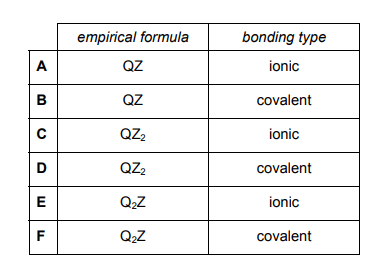
Explanation
The correct answer is C.
Looking at element Q first, its atomic number is 12. This shows that it has 12 electrons in total. Therefore, its electronic configuration is 2,8,2 which indicates that it is a Group 2 metal (with two electrons in its outer shell). Element Z, on the other hand, has an atomic number of 9 i.e. it has 9 electrons in total. Its electronic configuration is 2,7 suggesting that it is a halogen with seven electrons in its outer shell. The bonding that involves a metal and non-metal is always ionic so we can eliminate options B, D and F. If you think of any compounds which contain both Group 2 and 7, you will notice that you need two Group 7 ions to react with the Group 2 ion to ensure that all end up with full outer shells – as is the case with calcium chloride, for example which has the formula CaCl2. Therefore, the empirical formula is QZ2
Here are four statements about light:
1 In a vacuum, green light travels faster than blue light.
2 In a vacuum, the wavelength of red light is greater than the wavelength of green light.
3 In water, red light travels faster than it travels in a vacuum.
4 In water, the frequency of blue light is greater than the frequency of red light.
Explanation
The correct answer is E.
Statement 1 is incorrect because all colours of light travel at the same speed in a vacuum.
Statement 2 is correct because red light has a greater wavelength than green light.
Statement 3 is incorrect because light (and all other waves in the electromagnetic spectrum) travel fastest in a vacuum as there is no interference. Water is more optically dense and hence light will travel slower in it. The colour of the light is negligible.
Statement 4 is correct because the frequency of blue light is always greater than the frequency of red light. (Blue light has a smaller wavelength than red light). The fact that the light is travelling through water is negligible.
Which one of the following is a simplification of 
Explanation
The correct answer is B.
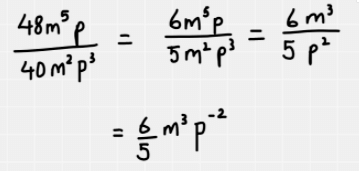
First, simplify the big numbers. Both are divisible by 8 so can be simplified to 6/5
Next, remember that when dividing indices with the same base you can simply subtract them
The p² in the denominator can be rewritten as p-².
Thus, B is the correct answer.
The diagram shows part of the nitrogen cycle.
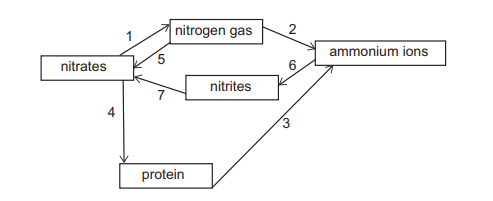
Explanation
The correct answer is A.
This question tests knowledge which is no longer included in the BMAT specification.
Denitrification is a process undertaken by denitrifying bacteria in the soil which convert nitrates into gaseous nitrogen. Therefore, option 1 is the only correct answer.
The diagram below shows the apparatus that can be used in fractional distillation.
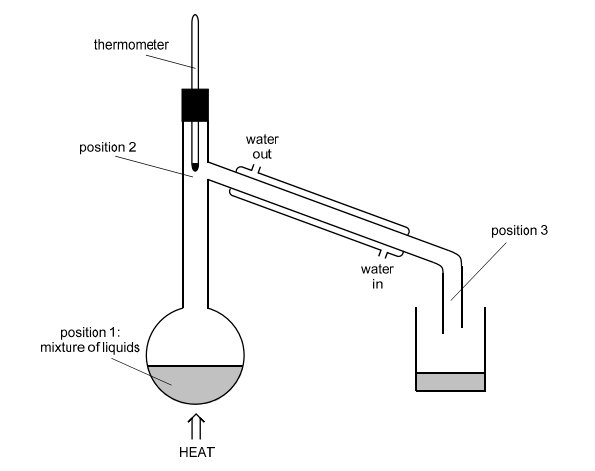
1 Covalent bonds between atoms are broken at position 1 and have reformed at position 3.
2 The particles are closer together at position 3 than at position 2.
3 The physical process at position 1 involves an exothermic change.
Explanation
The correct answer is C.
Statement 1 is incorrect because at position 1, one of the compounds that is being distilled is being boiled. During boiling, the covalent bonds between atoms are NOT broken – it is rather the intermolecular forces (like Van der Waals) which are being broken, Similarly, at position 3, condensation is occurring – where the intermolecular forces between the molecules of compound are being reformed NOT the covalent bonds.
Statement 2 is correct because at position 3, the particles are in the liquid state whereas in position 2, the particles are in the gaseous state. Particles are much closer in liquids than in gases.
Statement 3 is incorrect because the process occurring at position 1 is boiling. This requires/takes in heat in order to break the intermolecular forces between the molecules – therefore, it is an endothermic reaction as opposed to an exothermic one (which would give out heat).
A wave travelling through a material has a frequency of 50 Hz and a wavelength of 0.40 m.
Explanation
The correct answer is E.
This question requires the use of two equations:
- Wave speed = wavelength x frequency
- Time = Distance/speed
Wave speed therefore is 20 m/s ( as 0.4 x 50 = 20)
Therefore, the time it takes for the wave to travel 100m is 100/20 = 5 seconds.
My wallet contains two 50p coins and five 20p coins only.
I need 70p to buy an item.
Explanation
The correct answer is C.
In order to pick the exact money to buy the item, there are two possible ways of doing this:
- Picking the 50p first and then the 20p
- Picking the 20p first and then the 50p
If we start with 1) the probability of this occurring is:

The probability of 2) occurring is

If we add the probabilities of 1) and 2) we get the answer: 10/21
 Anonymous
Medicmind Tutor
Anonymous
Medicmind Tutor
Tue, 19 Oct 2021 23:03:41
Could draw a tree diagram to show possibilites although it may take longer
A sample of healthy human cells contains 4 cells. After they were allowed to divide 5 times using the same type of cell division, there were 128 cells in the sample.
1 All the cells would have the same number of chromosomes.
2 The cells were gametes.
3 The cells would be clones of the original cells.
4 This type of cell division is called meiosis.
Explanation
The correct answer is B.
We know that this type of cell division is mitosis NOT meiosis. This is because meiosis only involves two divisions and then the process stops. Gametes are NOT able to produce more gametes. Hence we can eliminate Statements 2 and 4. The rest of the answers can be worked out based on your knowledge of mitosis. Mitosis produces genetically identical cells so Statements 1 and 3 are correct.
Iron is extracted from iron ore (which contains Fe2O3) using carbon monoxide.
This overall reaction is slow and so must be heated.
The chemical equation for this reaction under certain conditions is shown below:
Fe2O3 + 3CO → 2Fe + 3CO2 ∆H = − 30 kJ /mol
Explanation
The correct answer is C.
Statement A is incorrect because in the compound Fe2O3, there are iron ions (which are positively charged). These are then reduced (gain electrons) to give iron (Fe) atoms.
Statement B is incorrect because the oxide ions in Fe2O3 each have a charge of -2.
Statement C is correct because by definition an oxidising agent causes the oxidation of another compound in the redox reaction whilst being reduced itself. Fe2O3 does get reduced to give Fe atoms whilst the CO gets oxidised (gains oxygen) to form CO2.
Statement D is incorrect as the enthalpy change is -30 kJ/mol. The negative sign indicates that this reaction is exothermic – it gives out heat energy.
Statement E is incorrect as this does not fit the criteria for an electrolysis reaction.
Quantities associated with a moving vehicle include its velocity, speed, momentum and kinetic energy.
Explanation
The correct answer is E.
This question requires you to know which of speed, velocity, momentum and kinetic energy are vector quantities i.e. they have both magnitude and direction.
Speed is a scalar quantity
Velocity is a vector quantity
Momentum is a vector quantity
Kinetic energy is a scalar quantity.
All four corners of a rectangle are on the circumference of a circle.
The rectangle has a perimeter of 24 cm.
The ratio of length :width for the rectangle is 3:1
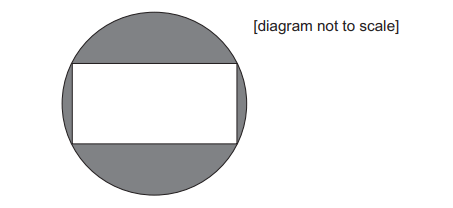
Explanation
The correct answer is F.
This question may seem initially complicated but if you break it down into chunks, it becomes very manageable.
To work out the area of the shaded region:
Area of the shaded region = Area of the circle – Area of the rectangle.
Let’s start by working out the area of the rectangle, for which we need its length and width.
They have provided us with the perimeter of the rectangle and the ratio length : width which is 3:1
The ratio shows us that the length of the rectangle is three times the width fo the rectangle so we can rewrite the length of the rectangle as follows:
Length (L) = 3 x width (W)
L = 3W
We can write an equation for the perimeter of the rectangle:
2L + 2W = 24
Let’s now substitute the L=3W into the above equation
6W + 2W = 24
8W = 24 so W = 3
Therefore, the length of the rectangle is 9cm and the width of the rectangle is 3cm.
Therefore, the area of the rectangle is 3 x 9 = 27cm²
Since we know the length and width of the rectangle, we can work out the diameter (d) of the circle using Pythagoras’ theorem
3² + 9² = d²
90 = d²
We can therefore write the diameter of the circle (and subsequently the radius of the circle) as follows:
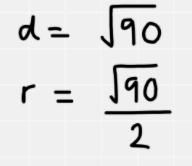
We now have enough information to work out the area of the circle using the formula for this:

We can now put this together with the area of the rectangle we worked out earlier:
The area of the shaded region is therefore:

 SB
Medicmind Tutor
SB
Medicmind Tutor
Sun, 10 Oct 2021 11:35:24
You should include that we know the distance between two corners of the rectangle is the diameter because angles in a semicircle are always 90 degrees.
The diagram shows three different types of animal cell.

Explanation
The correct answer is H.
Tissue is made up of a group of cells with a similar structure and function that work together to do a particular job.
Epithelial cells are part of several tissues like skin tissue, linings of intestines and other organs etc.
Blood cells are part of blood which is a tissue!
Muscle cells are part of muscle tissue.
The masses of atoms and molecules can be determined using a mass spectrometer. The masses can be shown as a series of peaks.
Element X exists as a diatomic molecule. The mass spectrum will show the mass of ions from individual atoms of X and from X2 molecules.
The mass spectrum for element X is shown below:
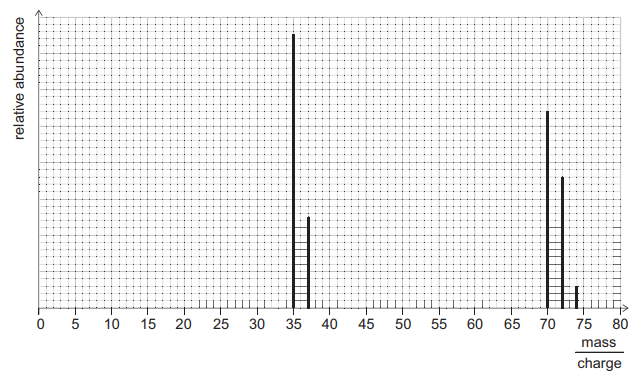
Explanation
The correct answer is B.
We can clearly see that there are two groups on this particular mass spectrum.
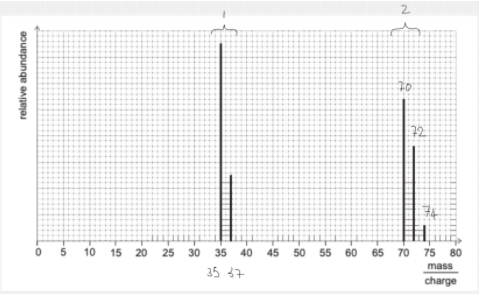
Group 1 consists of two peaks which have m/z values of 35 and 37
Group 2 consists of three peaks which have m/z values of 70, 72 and 74. This would suggest that the group 2 peaks are for the diatomic molecules of X made up of:
- 2 x 35 atoms
- 1 x 35 atom and 1 x 37 atom
- 2 x 37 atoms
Hence, there are two isotopes – so B is the correct answer.
A champion weightlifter raises a 200kg set of weights from the floor to above his head in one movement.
The bar is lifted through a vertical distance of 1.8m.
When the lift is completed the weightlifter holds the weights stationary for 2.0 seconds and then drops them to the floor.
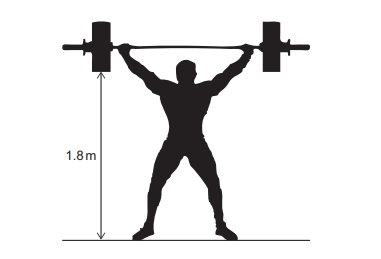
(gravitational field strength = 10N/ kg)
Explanation
The correct answer is E.
This is a classic question regarding the transfer of gravitational potential energy to kinetic energy (KE) . The formula for gravitational potential energy (GPE) = mass x g x height
We can therefore work out the GPE of the weights when they are lifted:
= 200 x 10 x 1.8 = 3600J
They have told us that the weights are held stationary so therefore:
GPE = KE
The formula for KE = ½ x mass x velocity2
Therefore, ½ x 200 x velocity2 = 3600
Velocity2= 36
So, the speed at which the weights hit the ground is the square root of 36 which is 6 m/s.
The first four triangular numbers are:

The difference between the first and second triangular numbers is 2.
The difference between the second and third triangular numbers is 3.
The difference between the third and fourth triangular numbers is 4.
All the triangular numbers follow this pattern.
The difference between the rth triangular number and the (r + 3)th triangular number is 126.
Explanation
The correct answer is B.
 F
Medicmind Tutor
F
Medicmind Tutor
Sat, 11 Sep 2021 06:08:29
Can you please explain the reason behind this question?
 k
Medicmind Tutor
k
Medicmind Tutor
Sun, 03 Oct 2021 11:26:00
Could you please explain why the correct answer to this question is B?
 SB
Medicmind Tutor
SB
Medicmind Tutor
Sun, 10 Oct 2021 11:43:37
1. Divide 126 by 3 to get the mean differences. 2. Add one and subtract one to get differences 41 42 and 42. 3. Difference between 1st and 2nd number is 2. 4. Therefore, difference of 41 must be between 40th and 41st number. 5. Therefore the value of r is 40.
 g
Medicmind Tutor
g
Medicmind Tutor
Tue, 02 Nov 2021 21:41:40
why do we divide 126 by 3?
 L
Medicmind Tutor
L
Medicmind Tutor
Tue, 16 Aug 2022 05:26:47
Because we want to find the mean difference of the 3 terms. Notice the question(r+3)th
The diagram shows a simple piece of apparatus that can be used to demonstrate some of the events involved in human ventilation.
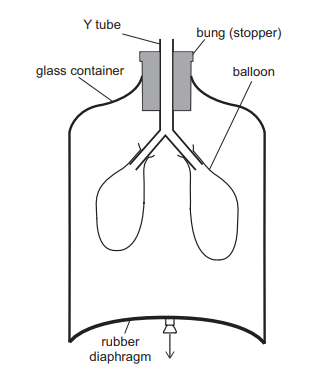
1 diaphragm relaxes
2 diaphragm contracts
3 volume of thorax increases
4 volume of thorax decreases
5 pressure in thorax increases
6 pressure in thorax decreases
Explanation
The correct answer is F.
The arrow shows the diaphragm moving downwards (flattening), which occurs when it contracts [2]. This increases the volume of the thoracic cavity [3], decreasing pressure inside the thorax [6], which causes pulmonary pressure to fall below atmospheric pressure, which causes air to move into the lungs down the pressure gradient.
Which of the following shows the correct structure of part of the polymer formed by the polymerisation of CH3 –CH=CH–CH3 ?
Explanation
The correct answer is E.
To work this out you need to ‘open up’ the double bond. The two central carbon atoms attached to the double bond are both also bonded to a methyl group and a hydrogen atom. This repeating unit is shown by E (imagine the methyl group on the left is moved above the consecutive carbon atom and the methyl group on the right is moved below the carbon atom before it in the chain).
A circuit consists of a 10Ω resistor and a variable resistor connected in series with a 6.0V battery. The variable resistor has a minimum resistance of 2.0Ω and a maximum resistance of 20Ω.
Explanation
The correct answer is B.
The total resistance in a series circuit is given by the sum of the resistance of all the resistors connected in series. So the maximum resistance would be 10+20=30, and the minimum would be 10+2=12. So, using I=V/R, the minimum current would be 6/30=0.2A and the maximum current would be 6/12=0.5A. The difference between these is: 0.5-0.2=0.3A.
The mean mass of a sweet in a bag of 20 sweets must be greater than 10 grams but not greater than 10.5 grams.
A bag is being filled with sweets. The mean mass of the first 16 sweets is exactly 9.5 grams.
Four more sweets, each of mass x grams, are added to the bag to bring the mean mass of the 20 sweets into the correct range.
Explanation
The correct answer is A.
The total mass of the first 16 sweets is: 16×9.5=152 grams. Then 4 more sweets are added, with a total mass of 4x. The mean mass of the 20 sweets is given by: (152+4x)/20. This is greater than 10 grams but not greater than 10.5 grams (so it can be greater than or equal to 10 grams): 10<(152+4x)/20_<10.5. Now we need to do some manipulation to isolate x: 200<152+4x_<210, 48<4x_<58, 12<x_<14.5.
 SB
Medicmind Tutor
SB
Medicmind Tutor
Sun, 10 Oct 2021 11:47:05
Why can't you do 10 < (9.5 + 4x) / 5 _< 10.5?
An animal cell is surrounded by a very dilute glucose solution which has a lower concentration of glucose than the glucose solution in the cytoplasm of the cell. There is net movement of glucose molecules and water molecules into the cell.
A second, identical cell is treated for a short time with a chemical which inhibits respiration. The cell is then surrounded by the same glucose solution.
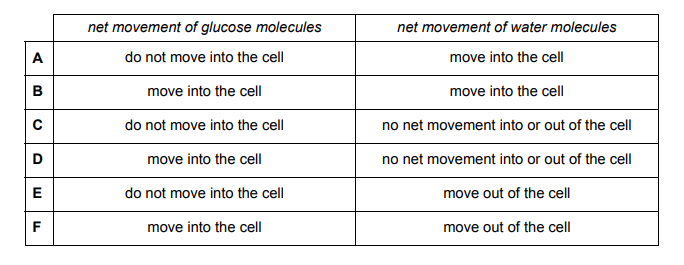
Explanation
The correct answer is A.
The second cell is treated with a chemical which inhibits respiration. This means the cell will fail to generate ATP, which is needed to actively transport glucose across its cell membrane. Therefore there would be no net movement of glucose into the cell. Eliminate B, D and F. Water moves passively across the cell membrane by osmosis, and since there will still be a concentration gradient for the movement of water into the cell (possibly a larger one due to an increased cytoplasmic concentration of glucose due to lack of breakdown by respiration), the answer is A.
 s
Medicmind Tutor
s
Medicmind Tutor
Wed, 29 Jun 2022 15:42:39
glucose is transported by facilitated diffiusion
 1
Medicmind Tutor
1
Medicmind Tutor
Tue, 16 Aug 2022 05:32:30
The concentration of glucose in the solution is lower, so active transport is needed to transport glucose against concentration gradient into the cell. Thus, no respiration, no ATP, no active transport, no glucose movement.
A compound of oxygen and fluorine has a relative molecular mass which is twice that of its empirical formula mass. 105 g of the compound contains 57g of fluorine.
(Ar values: O = 16; F = 19)
Explanation
The correct answer is C.
The compound has a relative molecular mass which is twice that of its empirical formula mass, so eliminate A, B and D because their respective molecular and empirical formulae are identical (because there is an odd number of at least one of the atoms). The empirical formulae of the remaining options, C and E are identical, OF. Doubling this would give O2F2, which is C.
The radioactive isotope plutonium-244 becomes radon-220 after a succession of decays. The atomic number of plutonium is 94 and the atomic number of radon is 86.
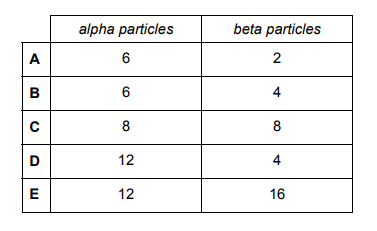
Explanation
The correct answer is B.
An alpha particle consists of 2 protons and 2 neutrons, so for each alpha particle lost the mass number would decrease by 4 and the atomic number by 2. Loss of a beta particle would cause the stomach number to decrease by 1. The mass number has decreased by 244-220=24 and the atomic number by 94-86=8. This means that 24/4=6 alpha particles must have been lost (because loss of a beta particle does not affect the mass number). Loss of 6 alpha particles would cause the atomic number to decrease by 6×2=12, but the actual change was 8, so 4 beta particles must have been lost (12-8=4).
Which one of the following is a simplification of 
Explanation
The correct answer is B.
You can factorise x2+2x-3 into (x+3)(x-1). Now make the denominators of each fraction the same by multiplying both the numerator and denominator of the first fraction by (x+3). This gives:

Which factorises to answer B.
In a type of fruit fly the brown body colour allele is dominant to the black body colour allele. A male fruit fly heterozygous for body colour and a female fruit fly heterozygous for body colour were allowed to mate, producing offspring.
Explanation
The correct answer is C.
Two heterozygotes are being crossed (BbxBb). This will give us 3 possible genotypes, BB, Bb and bb, which would have phenotypes of brown, brown and black respectively. Therefore the ratio of genotypes to phenotypes possible would be 3:2.
Xenon gas reacts with fluorine gas to form gaseous xenon hexafluoride at high temperature and pressure. The overall energy change is − 330 kJ / mol.
Under these conditions, the F–F bond energy of the fluorine gas is 158kJ / mol.
Explanation
The correct answer is C.
The equation for this reaction would be: Xe + 3F2 → XeF6. The enthalpy change of the reaction= sum of enthalpies of bond broken- sum of enthalpies of bond formed. Therefore: -330=3(158)-6(Xe-F). Rearranging to get Xe-F: -110=158-2(Xe-F), 268=2(Xe-F), 134=(Xe-F).
 savraj
Medicmind Tutor
savraj
Medicmind Tutor
Tue, 29 Aug 2023 19:07:44
can someone explain this to me? i dont really understand the solution.
 samsam
Medicmind Tutor
samsam
Medicmind Tutor
Mon, 16 Oct 2023 14:23:07
Xenon hexafluoride has 1 xenon atom and 6 fluorine atoms. (The prefix hexa- means six) Fluorine is diatomic gas. In order to receive 6 fluorine atoms, we need to use three fluorine gas molecules (3F2) Xenon is a noble gas so it is present as an atom only. We can write down the equation too. Xe + 3F2 -> XeF6 ∆H = -330 kJ/mol Number of F – F bonds broken = 3 Energy = 158 x 3 = 474 kJ/mol There are 6 Xe – F bonds. Let energy of 1 Xe – F bond = M (any letter) 474 + 330 = 6M 6M = 804 M = 134 kJ/mol
The radioactive isotope carbon-14 is found in living material in small quantities. There are approximately 1000 carbon-14 atoms for every 10¹5 carbon-12 atoms. Whilst the material is still living this ratio remains constant, because even though the carbon-14 is decaying, it is being constantly replenished. When the material dies the carbon-14 decays and is not replaced. The half-life of carbon-14 is about 6000 years.
In a bone the ratio of carbon-14 to carbon-12 atoms is found to be 100 : 10¹5 .
Explanation
The correct answer is E.
 V
Medicmind Tutor
V
Medicmind Tutor
Sun, 17 Oct 2021 13:44:06
I am not sure if this is the reason, but could you explain why it is E? - Is it because 3 half lives bring the value from 1000 to 125 which is just over 100 so the age should be just over 6000*3 = 18000 years.
 guest
Medicmind Tutor
guest
Medicmind Tutor
Fri, 29 Oct 2021 18:24:09
When bone is alive the ratio = 1000:1015 In a bone the ratio = 100:1015 Calculating how many half-lives to decrease from 1000 atoms to 100: 1 half-life = 500 2 half-lives = 250 3 half-lives = 125 4 half-lives = 62.5 Therefore 1000 atoms decaying to 100 is around 3.5 half lives. 3.5 x 6000 = 21,000 which is ~20,000.
 jopper
Medicmind Tutor
jopper
Medicmind Tutor
Mon, 01 Nov 2021 18:03:29
Same as V
BMAT 2018 S2 Review Screen
Instructions
Below is a summary of your answers. You can review your questions in three (3) different ways.
The buttons in the lower right-hand corner correspond to these choices:
1. Review all of your questions and answers.
2. Review questions that are incomplete.
3. Review questions that are flagged for review. (Click the 'flag' icon to change the flag for review status.)
You may also click on a question number to link directly to its location in the exam.
BMAT 2018 S2 Section
Final Answer Review Screen
Instructions
This review section allows you to view the answers you made and see whether they were correct or not. Each question accessed from this screen has an 'Explain Answer' button in the top left hand side. By clicking on this you will obtain an explanation as to the correct answer.
At the bottom of this screen you can choose to 'Review All' answers, 'Review Incorrect' answers or 'Review Flagged' answers. Alternatively you can go to specific questions by opening up any of the sub-tests below.
BMAT 2018 S2 Section
TI-108
Let's get acquainted ?
What is your name?
Nice to meet you, {{name}}!
What is your preferred e-mail address?
Nice to meet you, {{name}}!
What is your preferred phone number?
What is your preferred phone number?
Just to check, what are you interested in?
When should we call you?
What time works best for you? (UK Time)
How many hours of 1-1 tutoring are you looking for?
My WhatsApp number is...
For our safeguarding policy, please confirm...
For our safeguarding policy, please confirm...
Which online course are you interested in?
What is your query?
SubmitYou can apply for a bursary by clicking this link
https://www.medicmind.co.uk/medic-mind-foundation/Sure, what is your query?
SubmitLoading...
Thank you for your response.
We will aim to get back to you within 12-24 hours.
Lock in a 2 Hour 1-1 Tutoring Lesson Now
If you're ready and keen to get started click the button below to book your first 2 hour 1-1 tutoring lesson with us. Connect with a tutor from a university of your choice in minutes. (Use FAST5 to get 5% Off!)
Buy Now for £70